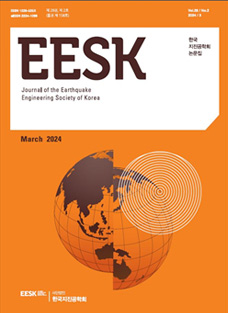1. Introduction
Recently, many structural engineers in practice are overestimating the seismic response of a structure with a sunken mat foundation due to the lack of informations and study results on the structure-foundationsoil interaction effects.
Seismic responses of a structure built on surface and embedded mat foundations were investigated using the analytical or numerical method by many researchers including Ray and Joseph, Kim, and Kim and Roesset [1-4]. However, study result on the seismic analyses of a structure built on sunken (excavated) mat foundation using a 3D finite element method is practically hard to find from the databases for domestic and foreign papers.
In this study, seismic responses of a structure built on a sunken mat foundation were carried out utilizing a home-made pseudo 3D finite element software to compare numerical results with those of surface and solid embedded mat foundations. The pseudo 3D finite element method was used by taking into account the 3D characteristics of a structure-foundation-soil system which is important for the response analyses of a building structure. Seismic analyses were performed with bedrock earthquake records of the Northridge Earthquake downloaded from the Pacific Earthquake Engineering Research Center (PEER) database [5]. The bedrock earthquake records were scaled to represent the weak-moderate earthquake motions.
Shear wave velocity (Vs) of the base rock was assumed to be 760 m/s, and the soil depth of the underlying soil was assumed to be 30 m. Also three shear wave velocities of 180 m/s, 360 m/s and 760 m/s were considered to represent weak (soft), medium and stiff soil layers.
Effects of foundation radius, foundation embedment, shear wave velocity of a soil layer and sunken depth were investigated for the parametric studies using the home-made pseudo 3D finite element program of P3DASS in the frequency domain.
2. Modelling
Seismic analysis of a structure was performed by idealizing a structure as a single degree of freedom system (SDOF) and digitalizing the underlying foundation-soil-pile system as 3D finite elements shown in Fig. 1.
For the study, a code of Pseudo 3-dimensional Dynamic Analysis of Structure-soil System (P3DASS) [6], which was developed originally by Kim in 1987 and modified by Kim and Roesset in 2004 [4], was utilized to carried out the dynamic analyses of a structure-foundationpile- soil system. The program was developed in the cylindrical coordinate system for the axis symmetric system in the frequency domain taking into account vertically propagating waves travelled from the base bedrock.
The mat foundation was modeled as a circular rigid foundation for the sake of the cylindrical coordinate system. The core region was discretized by toroidal finite elements for the numerical seismic analysis [7]. And the lateral boundary was placed at the edge of a rigid foundation considering elastic soil layers to represent the far field [8]. The bottom boundary was assumed to be a bedrock. More detailed informations on the P3DASS program can be found in the reference paper of [4].
In the study, the soil layer lying on the bedrock was assumed to be 30 m thick (H), and it was also assumed to be elastic, homogeneous and isotropic with a unit weight of 18 kN/m3, Poisson’s ratios (ν) of 0.35 and damping ratio of 0.05. Shear wave velocities of 180 m/s, 360 m/s and 760 m/s were considered for the soil layer.
A structure built on a mat foundation, which is supported by 225 High-strength prestressed concrete (HPC) end-bearing piles having a diameter of 500 mm, was modeled as a single degree of freedom (SDOF) system assuming a damping ratio of 0.05 for the seismic analysis. And pile head and pile tip were fixed into a rigid mat foundation and the bedrock respectively.
A pile group arranged in the grid form was transformed into the circular form having the equivalent moment of inertia. Area and moment of inertia of a pile are 0.1113 m2 and 0.00254 m4, and Young’s modulus, Poisson’s ratio and damping ratio of a pile are 39,216 MN/m2, 0.25 and 0.05 respectively.
For an embedded mat foundation, the foundation was assumed to be rigid with the mass density of 3.564 kN/m3 taking into account the usage of a basement parking garage.
In this study, seismic analyses were performed with the 1994 Northridge earthquake component of MTW090 (seismic intensity of approximately 0.1344 g) which was downloaded from the database of PEER [5].
Outcrop earthquake record was scaled to 0.1173 g (2/3 of 0.176 g in 2400 year recurrence period) to represent effective earthquake record of a 1000 year recurrence period in the moderate seismic area, and an engineering bedrock earthquake record of MTW090r (seismic intensity of 0.0579 g) at 30 m below the outcrop (a shear wave velocity of 760 m/s) was generated by a de-convolution process. Response spectra of outcrop and bedrock earthquake records are shown in Fig. 2.
Seismic analyses of a SDOF system built on the soft soil layers were performed in the frequency range of 0-30 Hz, and response spectrum of a SDOF system was calculated in the a period range from 0 to 2 seconds with the interval of 0.05 seconds.
3. Study on the effects of foundation characteristics
Effect of a foundation type on the response of a structure was investigated by taking into account three foundation types of surface foundation, solid embedded foundation and sunken embedded foundation.
Foundation types for study models are shown in Fig. 3. The depth of a soil layer (H) was assumed to be 30 m, and the radius of a circular foundation to investigate the effect of a foundation radius was taken into account three different cases of 10 m, 30 m and 50 m. The embedment effect of a foundation on the response spectrum was also investigated for three different foundation types of surface, embedded and sunken foundations. The nominal embedment depth of 1 m was considered to simulate the surface foundation, and the embedment depths (E) of 10 m, 20 m and 30 m were taken into account for solid and sunken embedded foundations.
Also, the effects of the soil characteristics on the response spectrum were studied considering shear wave velocities of 180 m/s, 360 m/s and 760 m/s.
3.1 Effect of the foundation radius
Parametric study results of the foundation radius effect are shown in Fig. 4 for three different foundation types.
In the case of a surface foundation, the effect of the foundation radius on the structural response is less than 2% even with a soft soil layer (Vs=180 m/s), and it is minimal with a stiff soil layer (Vs=760 m/s) as shown in Fig. 4(a). Seismic response of a structure is increased with medium or stiff soil layer due to the soil amplification, but it is decreased with a weak soil layer in the short period range.
In the case of solid embedded foundation with the embedment depth of 20 m, the structural response was the smallest with a large foundation radius of 50 m for all soil types, showing less than 8% difference compared with the case of a radius of 30 m as shown in Fig. 4(b).
The structural response with a sunken foundation embedded 20m in the soil layer shows the smallest variance of less than 4% for all different foundation radii with the weak soil layer (Vs=180 m/s). Also, the responses for medium and stiff soil layers in Fig. 4(c) show the smallest responses with the foundation radius of 50 m, but show less than 6% response difference comparing to the responses with the foundation radius of 30 m. And those were decreased as the shear wave velocity and the foundation radius are increased,
The responses with both solid and sunken embedded mat foundations laid on a weak soil layer also indicate that the difference in the response spectrum is less than 5% if the foundation radius is larger than 30 m as shown in Fig. 4(d).
Effective maximum response accelerations of SDOF system are summarized for three different soil layers and three foundation types in Table 1. The ratios of response acceleration with respect to the response acceleration for the foundation radius of 50 m are also shown. It can be seen that the response difference between two foundations with the radii of 30 m and 50 m is less than 8% even in the case of 20 m deep embedment.
Therefore, it is reasonable to assume a foundation radius to be larger than 30 m for the seismic analysis of the structure-soil system.
3.2 Effect of the foundation embedment
Investigation of foundation embedment effects was performed for surface, solid embedded and sunken embedded foundations, and the results are shown in Fig. 5. For the study, soil layer depth and foundation radius were fixed to be 30 m.
In the case of solid embedded mat foundation with the shear wave velocity of 180 m/s, the response spectra were reduced approximately 33%, 52% and 67% with respect to that of a surface foundation for three embedment depths of 10 m, 20 m and 30 m respectively as shown in Fig. 5(a).
And, the response spectra with the shear wave velocity of 360 m/s shown in Fig. 5(b) were reduced approximately 28%, 49% and 72% for the different embedment depths of 10 m, 20 m and 30 m respectively.
Also, the response spectra with the shear wave velocity of 760 m/s were reduced approximately 14%, 28% and 49% for three embedment depths of 10 m, 20 m and 30 m respectively as shown in Fig. 5(c).
In the case of a sunken mat foundation, only the response spectra with the shear wave velocity of 360 m/s are shown in Fig. 5(d). The responses were reduced approximately 25%, 50% and 72% compared to the response spectra of a surface foundation for three embedment depths of 10 m, 20 m and 30 m respectively.
These study results indicate that the structural response with the soft or medium soil layer having shear wave velocities of 180 m/s or 360 m/s were reduced approximately 30%, 50% and 70% with the embedment depths of 10 m, 20 m and 30 m respectively for both solid and sunken embedded mat foundations. And the response with the stiff soil layer of shear wave velocity of 760 m/s shows somewhat smaller reduction rates than the responses of soft and medium soil layers due to the lesser soil amplification, but the response reduction due to the foundation embedment is still significant.
3.3 Effect of the shear wave velocity of a soil layer
The effect of the shear wave velocity on the seismic response was studied for solid and sunken embedded mat foundations. The radius of a foundation was assumed to be 30 m, and the embedment depths of a foundation were assumed to be 10 m and 20 m. Three shear wave velocities of 180 m/s, 360 m/s and 760 m/s were taken into account in this study.
Response spectrum of a solid embedded mat foundation shown in Fig. 6(a) was amplified less with a deeper embedment depth of 20 m for all three shear wave velocities.
Amplification ratios with medium and stiff soil layers having shear wave velocities of 360 m/s and 760 m/s were increased considerably, however amplification ratio with the soft soil layer of 180 m/s was dropped very much in the short period range from 0.1 to 0.8 seconds due to the fundamental period change of a soil layer.
Also, response spectra with a sunken mat foundation shown in Fig. 6(b) have very similar trends to the response spectra with a solid embedded mat foundation.
Study results on the effect of the shear wave velocity of a soil layer show that response spectrum with a stiff shear wave velocity was amplified considerably throughout the period range, however response spectrum with a weak shear wave velocity was amplified a little in the short period range due to the longer fundamental period of a soil layer avoiding the resonance with the seismic base motion.
4. Effect of the sunken depth of a foundation
The effect of the sunken depth of a foundation on the seismic response was studied for sunken embedded mat foundations. Three shear wave velocities of 180 m/s, 360 m/s and 760 m/s were considered for the study. The radius of a foundation was assumed to be 30 m, and three embedment depths of 10 m, 20 m and 30 m were investigated to check the effect of the sunken depth.
Response spectra for embedded and sunken mat foundations are compared to investigate the sunken effect as shown in the Fig. 7(a), (b) and (c).
Responses of a structure built on the soft soil layer having a shear wave velocity of 180 m/s are shown in Fig. 7(a), and maximum responses differences are approximately 3.1%, -1.7% and 0% between solid and sunken embedded foundation with the embedment depths of 10 m, 20 m and 30 m respectively.
In the case of a shear wave velocity of 360 m/s, response differences shown in Fig. 7(b) are approximately 4.2%, -2.5% and 0%, and those for the shear wave of 760 m/s are approximately 2.0%, -1.3% and 0% as shown in Fig. 7(c).
Therefore, response difference between solid and sunken embedded mat foundation was small and not significant for all different shear wave velocities and embedment depths. It is because the seismic motion at the bottom of a sunken embedded foundation is a little different from the seismic motion at the top of the solid embedded foundation.
Even though response difference is minimal and the responses are similar, it should be reminded that the natural period of a structure built on a sunken mat foundation will be longer than that built on a solid embedded mat foundation due to the sunken depth of a foundation if the structures have the same ground stories.
It should be also noticed that the exciting base motion in the seismic analysis of a structure built on solid or sunken embedded foundation is the seismic motion just benearth the embedded foundation, and it is not the seismic motion at the ground level.
5. Conclusions
Seismic response analyses of a structure built on a sunken mat foundation were performed to compare them with seismic responses of a structure built on a solid embedded mat foundation.
Soil layer lying on the stiff bedrock was assumed to be elastic, homogeneous and isotropic, and shear wave velocities of 180 m/s, 360 m/s and 760 m/s were also assumed to simulate weak, medium and stiff soil layers respectively.
Depth of soil layers was specified to be 30 m, and radius of an equivalent circular foundation was assumed to be 30 m for the sake of the research convenience in accordance of the parametric study results. And embedment depths of a foundation were taken into account to be three different cases of 10 m, 20 m and 30 m.
Seismic analyses were performed with a 1994 Northridge earthquake component of MTW090 which was downloaded from the database of Pacific Earthquake Engineering Research Center. Outcrop earthquake record was scaled to 0.1173 g to represent a weak-moderate earthquake, and then an engineering bedrock earthquake record of MTW090r (intensity of 0.0579 g) at the 30 m below the outcrop was generated by a de-convolution process assuming a soil layer of a shear wave velocity of 760 m/s.
In the parametric study, a foundation radius of 30 m or lager was reasonable for the seismic analysis of the structure-soil system. The embedment effect on the seismic responses of a structure was similar for both solid and sunken embedded mat foundations, showing larger response reduction with deeper embedment or rigider soil layer.
According to the study results on the effect of the shear wave velocity of a soil layer, response spectrum with a weak (soft) soil layer was amplified less in the short period range compared to that of a medium or stiff soil layer due to the longer fundamental period of a soil layer which is enough to avoid the resonance with the exciting base motion.
Response difference between rigid and sunken embedded mat foundation was small and not significant for all different shear wave velocities and embedment depths. It is because the seismic motion at the top of a solid embedded mat foundation is just a little different from the seismic motion at the bottom of a sunken embedded mat foundation. Even though response difference is minimal and the responses are similar, it should be noticed that the natural period of a structure built on a sunken mat foundation will be longer than that built on a solid mat foundation due to the sunken depth of a foundation.
It should be also noticed that the applying base motion for the seismic analysis of a structure built on solid or sunken embedded mat foundation should be the seismic motion just beneath the embedded mat foundation, and should not be the ground motion.




















